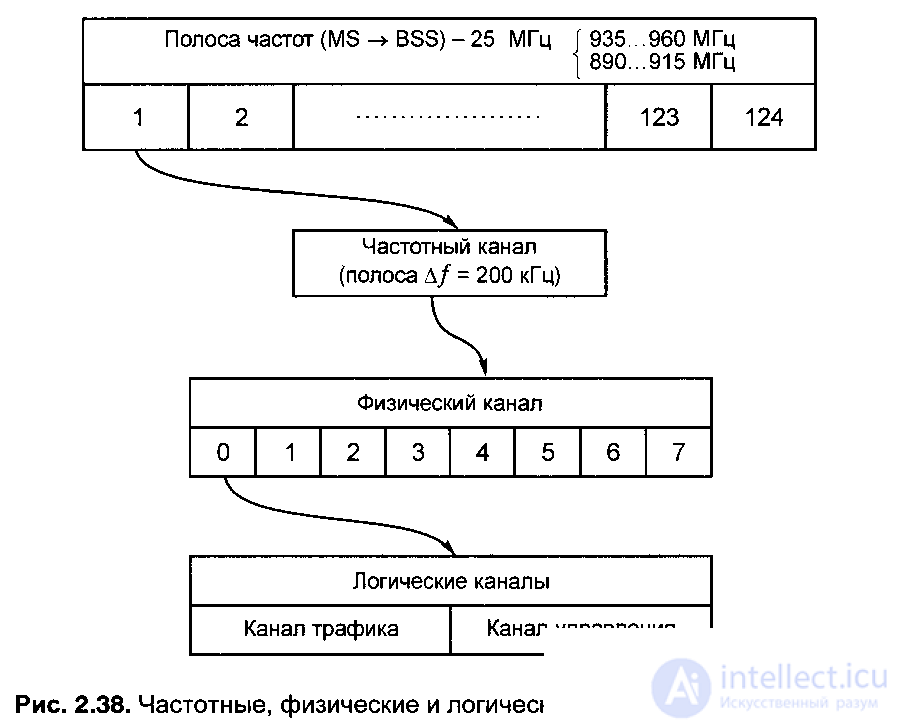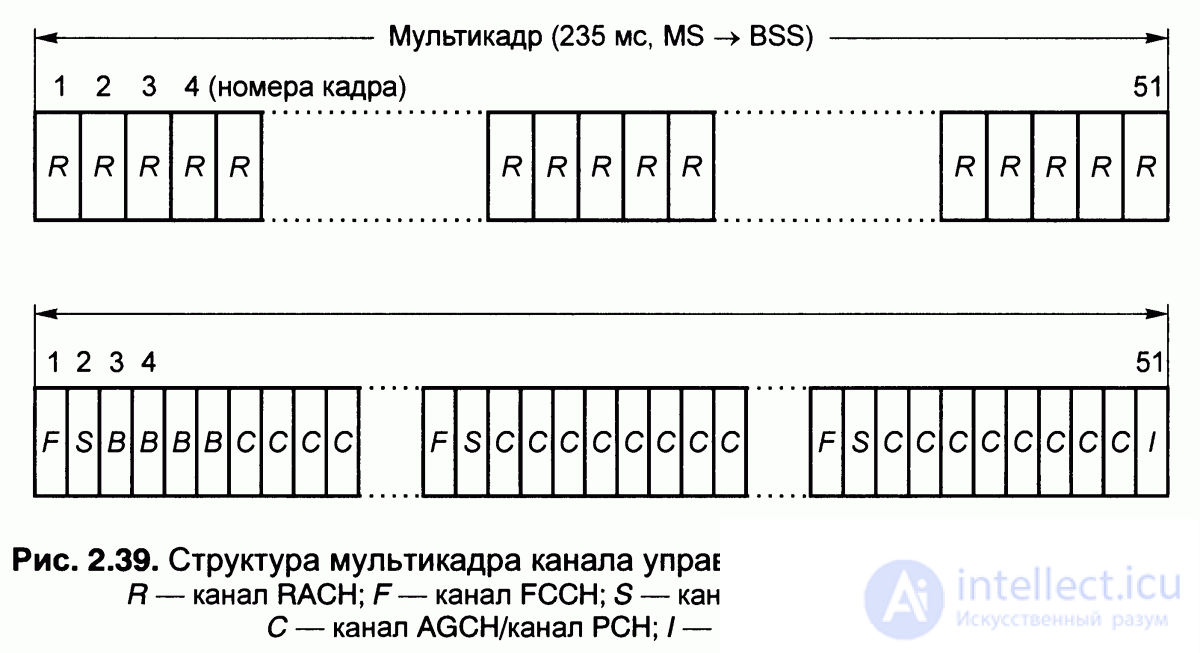Lecture
When considering the radio interface, traffic and control channels were already mentioned, which determine the organization of information exchange in a cellular mobile communication system between MS and BSS. Once again it must be emphasized that in addition to the actual speech information, the so-called signaling information, including control information and information monitoring the state of the equipment, must be transmitted via the communication channel. Below, the signal information will be understood as control information. Communication channels in the GSM standard can be divided into (Fig. 2.38): frequency; physical; logical channels [2.11].
 A frequency channel is a frequency band allocated to transmit information over a single communication channel.
A frequency channel is a frequency band allocated to transmit information over a single communication channel.
When using the TDMA method, as noted above, 8 communication channels are placed in one frequency channel, that is, 8 physical channels. This does not contradict the definition of the frequency channel. One frequency channel occupies the D / = 200 kHz band, so that only 45 / 0.2 - 1) = 124 frequency channels are placed in the full range, taking into account the guard bands.
The center frequency of the channel (in MHz) is associated with its number N:
- MS channel => BSS: / i = 890,200 + 0,200Af where 1 <N <124;
- BSS channel => MS: / 2 = 935,200 + 0.200-AG, where 1 <N <124.
We note that one frequency channel, strictly speaking, occupies two A / = 200 kHz bands, one for the MS channel => BSS, and the other for the BSS communication channel => MS. When using the SFH frequency hopping mode, different frequency channels are used successively in time for transmitting information from the same group of physical channels.
Physical channels
A physical channel in a TDMA system is a time slot with a specific number in a sequence of radio interface frames.
In the GSM standard, information of 8 physical channels is transmitted with full-rate coding, but with half-speed coding, one physical channel contains two traffic channels, information of which is transmitted in turn, through a frame, that is, at the same time, channel multiplexing is implemented 8 times with full-speed coding and 16 at half rate.
This is one of the main advantages of the digital generation of cellular mobile communications compared to analog.
So, the physical channel is formed by combining the time and frequency separation of signals and is defined as a sequence of radio frequency channels (with the possibility of frequency jumps) and time intervals of TDMA frames.
Go to the directory that would get acquainted with the prices and buy a GSM repeater
Each carrier contains 8 physical channels located in 8 time slots within a TDMA frame. Each physical channel uses the same time slot in each TDMA frame. Prior to the formation of the physical channel of the message (voice signal) and the data presented in digital form, are grouped and combined into logical channels.
Logical channels
Logical channels differ in the type of information transmitted in the physical channel. In principle, one of two types of logical channels can be implemented in a physical channel:
- traffic (communication channel) - for transmission of coded speech and data;
- control (signaling) - for the transmission of control and signaling signals, each of them, in turn, may in general exist in one of several options (types).
The structure of GSM logical channels in a simplified form is given in Table. 2.5. So, let us consider in sequence the types of logical channels and the types of channels within a view.
1. Traffic channels TCH (TrafficCHannel) are divided into:
- full speed TCH / FS (Full Speech) ',
- half rate TCH / HS (HalfSpeech), according to the type of voice transmission (speech).

Types of traffic channels for data transmission, not included in the table. 2.5, the following: TCH / F9,6, TCH / F4,8, TCH / H4,8, etc.
So, the voice transmission channel with the full speed TCH / FS is 22.8 kbit / s, and the PSC / HS is 11.4 kbit / s.
2. CCH control channels (Control CHannel) are divided into 4 types:
- broadcast control channels VSSN (Broadcast Control Channel);
- Common control channel CCCH (Common Control Channel);
- dedicated fixed control channels SDCCH (Standalone Dedicated Control Channel);
- Combined control channels ACCH (Associated Control Channel).
Channels BCCH are designed to transmit information from the BSS and MS in the broadcast mode, that is, without addressing to any particular MS.
The number of broadcast control channels VSSN includes:
- FCCH frequency correction channel (Frequency Correction CHannel), necessary to adjust the frequency of the MS mobile station to the frequency of the base BTS;
- SCH synchronization channel (SynchronizationCHannel) used for personnel synchronization of MS mobile stations, as well as a common information channel that does not have a separate name.
Common management channels for CCCH include:
- a PCH call channel (Paging CHannet) used to call MS mobile station;
- AGCH access grant channel (Access Grant CHannet), necessary to assign a fixed control channel, information of which is also transmitted from the base station to the mobile MS;
- a random access channel RACH (Random Access CHannet), which serves to exit from the mobile station MS to the base BTS with a request to assign a dedicated control channel. When transmitting information via CCCH channels, the reception of information is not accompanied by confirmation.
The dedicated fixed control channels of the SDCCH (used in the two variants not reflected in Table 2.5) are autonomous control channels for transmitting information from the BSS to the MS and in the opposite direction.
Combined ACCH control channels, also used to transmit information in both directions (MS <=> BSS) and having several options (not reflected in Table 2.5), include:
- slow combined control channel SACCH (Slow Associated Control Channet), which is used in the forward channel (BSS => MS) to send a command to set the output power level of the MS mobile station transmitter, and in the reverse channel (MS => BSS) to transmit data about the level of installed capacity. The SACCH channel is combined with the traffic channel (frame 13 from the traffic channel multiframe) or with the SDCCH channel);
- fast combined control channel FACCH (Fast Associated Control Channel), which is used to transmit commands when the mobile station moves from cell to cell, that is, during a handover. The FACCH channel is combined with the traffic channel, replacing speech information in the corresponding slot, and this replacement is marked with a hidden flag (the S field in Fig. 2.32 and Fig. 2.39).
In contrast to duplex traffic channels and common control channels placed in the traffic channel of the radio interface, the simplex control channels BCCH and CCCH are located in the zero slot of the control channel channels of the radio interface on the so-called carrier SSCHs present in the cells.
RACH messages can be transmitted in the zero slot of any frame within the 51-frame multiframe of the control channel (Fig. 2.39), and the RACH message is transmitted by the mobile station once in 235 ms, that is, only in one of the multiframe frames, and is used slot structure corresponding to the access bundle.
Multi-frame (235 ms, MS-> BSS)

Messages of the BCCH and CCCH channels transmitted from the base station to the mobile ones are placed in zero slots of the 50 frames of the multiframe of the radio interface control channel (Fig. 2.21) and TDMA frames (Fig. 2.32).
The last 51 frame of the multiframe remains free I (Idle).
The first 50 frames are divided into 5 blocks of 10 frames:
- at the beginning of each block, FCCH messages are transmitted (slot structure - frequency correction packet);
- then the SCH message is transmitted (slot structure - synchronization packet);
- then, in the first block, 4 messages of the BCCH channel are transmitted;
- then 4 messages of the AGCH channel or the PCH channel are transmitted;
- in the remaining 4 blocks, all eight messages are allocated to the channel AGCH or PCH.
Messages of logical control channels in most cases are encoded with significant redundancy in order to protect against errors in the transmission of information.
Comments
To leave a comment
GSM Basics
Terms: GSM Basics